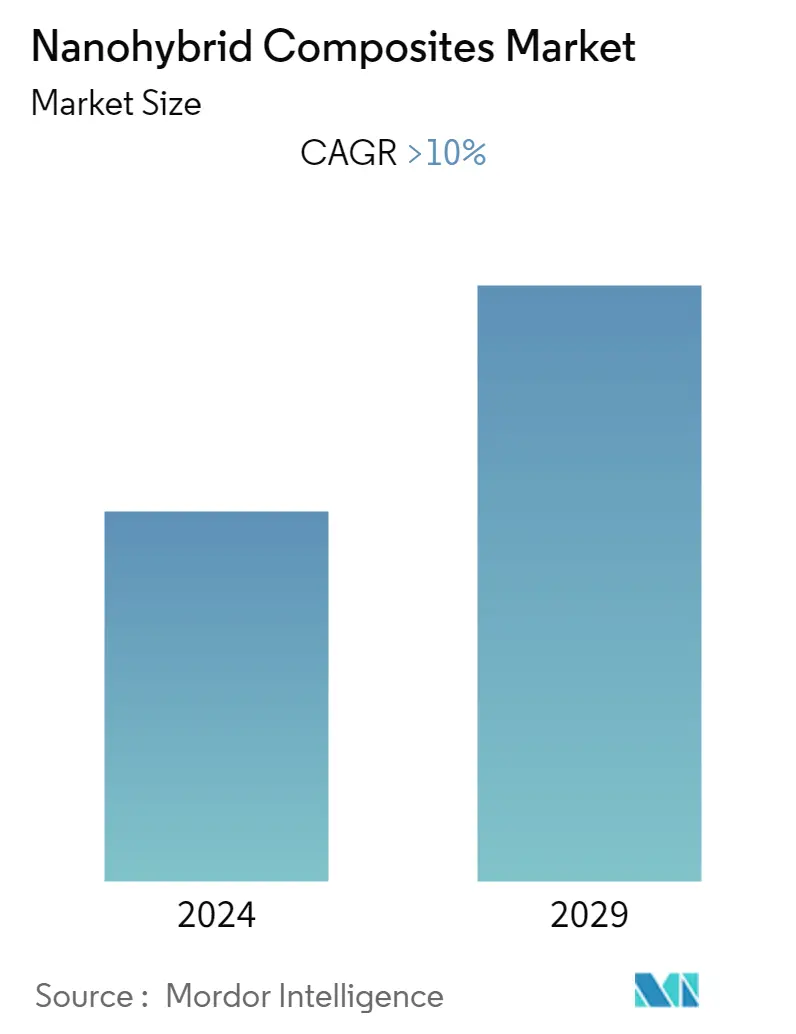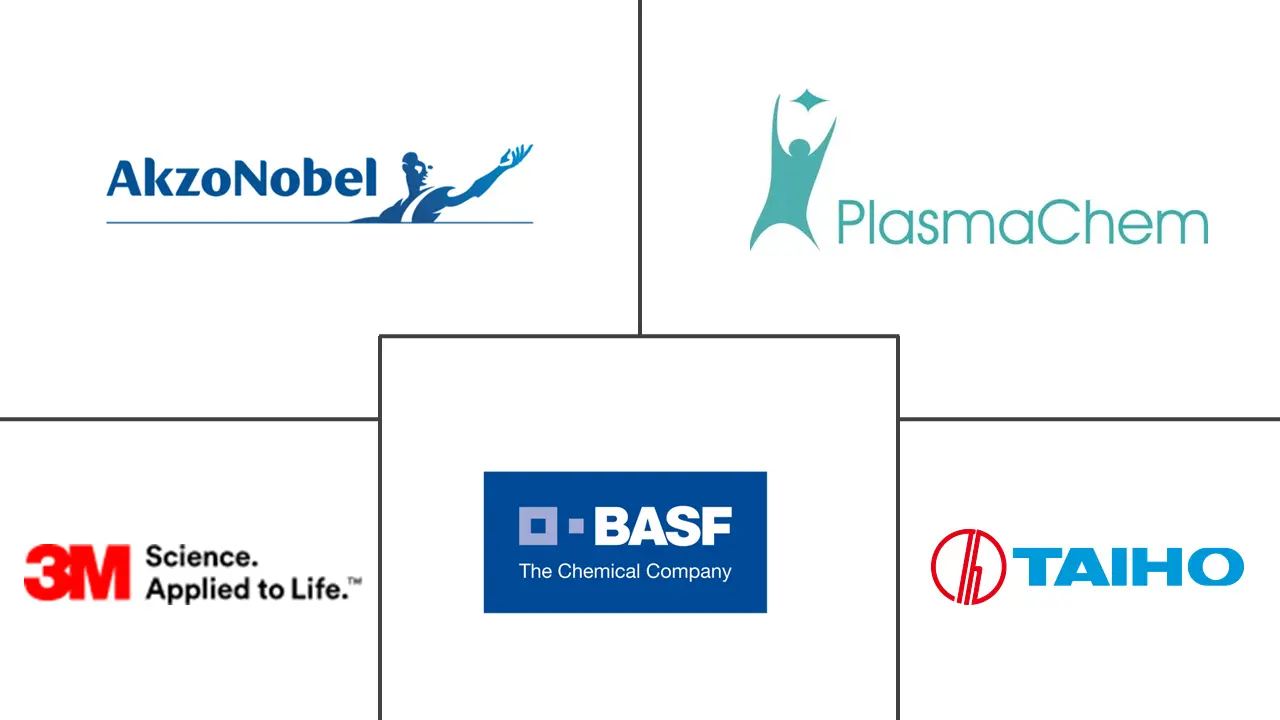Market Size of Nanohybrid Composites Industry

| Study Period | 2019 - 2029 |
| Base Year For Estimation | 2023 |
| CAGR | 10.00 % |
| Fastest Growing Market | Asia-Pacific |
| Largest Market | North America |
| Market Concentration | High |
Major Players
*Disclaimer: Major Players sorted in no particular order |
Nanohybrid Composites Market Analysis
The nanohybrid composites market is expected to register a CAGR of greater than 10% during the forecast period.
The COVID-19 pandemic harmed the global nanohybrid composites market. The worldwide market for nanohybrid composites reached its peak before the pandemic, but it only had minimal growth in 2020 owing to the COVID-19 pandemic. Substantial growth was predicted to return in 2021 as the market for nanohybrid composites' intrinsic driving drivers remained constant. Currently, the market has recovered from the pandemic and is growing at a significant rate.
- Over the short term, the increasing usage of nanohybrid composites in the dentistry industry is driving the market over the forecasted period.
- However, substitutions like nano-filled composites are expected to have major limitations on the growth rate of the nanohybrid composites market during the projected period.
- Nevertheless, the potential uses of nanohybrid composites in many technical fields are creating new opportunities for this market segment in the future.
- The Asia-Pacific region dominated the market globally, with the largest consumption coming from countries such as China and India, and this is expected to remain the same in the future.
Nanohybrid Composites Industry Segmentation
Nanohybrid composites are heterogeneous or hybrid materials created at the nanometric scale by combining polymers with inorganic solids (from clays to oxides). Its structures have been discovered to be more complex than those of microcomposites.
Market segments for nanohybrid composites include geography (Asia-Pacific, North America, Europe, and the rest of the world), application, and material types. By material types, the market is segmented into silica (SiO2), titanium dioxide (TiO2), zirconia (ZrO2), carbons, and metals. By application, the market is segmented into dental materials, electrical and electronics, paints and coatings, and other applications. The report also offers market sizes and forecasts for 11 countries across major regions. For each segment, market sizing and forecasts have been done based on revenue (USD million) for all the above segments.
| Material Type | |
| Silica (SiO2) | |
| Titanium dioxide (TiO2) | |
| Zirconia (ZrO2) | |
| Carbons | |
| Metals |
| Application | |
| Dental Materials | |
| Electrical and Electronics | |
| Paints and Coatings | |
| Other Applications |
| Geography | |||||||
| |||||||
| |||||||
| |||||||
|
Nanohybrid Composites Market Size Summary
The nanohybrid composites market is experiencing a robust recovery and significant growth, driven by their increasing application in various industries, particularly dentistry. The market, which faced challenges during the COVID-19 pandemic, has rebounded due to the consistent demand for nanohybrid composites in dental materials. These composites, known for their superior mechanical properties and aesthetic appeal, are becoming the preferred choice for dental restorations, offering long-lasting and visually appealing solutions. The Asia-Pacific region, led by countries like China and India, continues to dominate the market, with North America also holding a significant share due to its advanced industrial applications and growing demand in the dental sector.
The market's expansion is further supported by the diverse applications of nanohybrid composites in engineering, electronics, and coatings, where their enhanced properties provide competitive advantages over traditional materials. Despite the emergence of substitutes like nano-filled composites, the unique benefits of nanohybrid composites, such as improved barrier properties and reduced polymerization shrinkage, are creating new opportunities for growth. The presence of major players like 3M, BASF SE, and Akzo Nobel N.V. in the market underscores its consolidated nature, with these companies driving innovation and development in nanohybrid technologies. As demand continues to rise, particularly in North America and emerging economies, the market is poised for sustained growth in the coming years.
Nanohybrid Composites Market Size - Table of Contents
-
1. MARKET DYNAMICS
-
1.1 Drivers
-
1.1.1 Growing Usage of Nanohybrid Composites in the Dental Industry
-
1.1.2 Other Drivers
-
-
1.2 Restraints
-
1.2.1 Substitutions like Nano-filled Composites
-
-
1.3 Industry Value Chain Analysis
-
1.4 Porter's Five Forces Analysis
-
1.4.1 Bargaining Power of Suppliers
-
1.4.2 Bargaining Power of Buyers
-
1.4.3 Threat of New Entrants
-
1.4.4 Threat of Substitute Products and Services
-
1.4.5 Degree of Competition
-
-
-
2. MARKET SEGMENTATION (Market Size in Value)
-
2.1 Material Type
-
2.1.1 Silica (SiO2)
-
2.1.2 Titanium dioxide (TiO2)
-
2.1.3 Zirconia (ZrO2)
-
2.1.4 Carbons
-
2.1.5 Metals
-
-
2.2 Application
-
2.2.1 Dental Materials
-
2.2.2 Electrical and Electronics
-
2.2.3 Paints and Coatings
-
2.2.4 Other Applications
-
-
2.3 Geography
-
2.3.1 Asia-Pacific
-
2.3.1.1 China
-
2.3.1.2 India
-
2.3.1.3 Japan
-
2.3.1.4 South Korea
-
2.3.1.5 Rest of Asia-Pacific
-
-
2.3.2 North America
-
2.3.2.1 United States
-
2.3.2.2 Canada
-
2.3.2.3 Mexico
-
-
2.3.3 Europe
-
2.3.3.1 Germany
-
2.3.3.2 United Kingdom
-
2.3.3.3 Italy
-
2.3.3.4 France
-
2.3.3.5 Rest of Europe
-
-
2.3.4 Rest of the World
-
2.3.4.1 South America
-
2.3.4.2 Middle-East and Africa
-
-
-
Nanohybrid Composites Market Size FAQs
What is the current Nanohybrid Composites Market size?
The Nanohybrid Composites Market is projected to register a CAGR of greater than 10% during the forecast period (2024-2029)
Who are the key players in Nanohybrid Composites Market?
3M, BASF SE, PlasmaChem GmbH, TAIHO Corporation and Akzo Nobel N.V. are the major companies operating in the Nanohybrid Composites Market.

